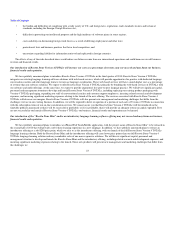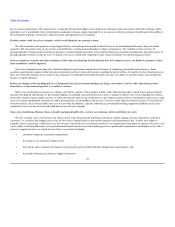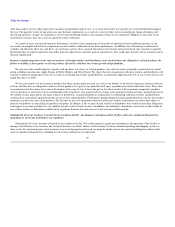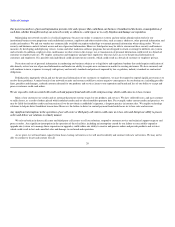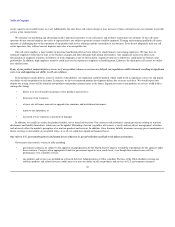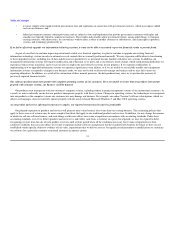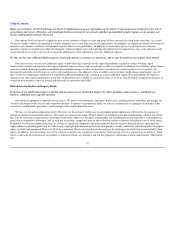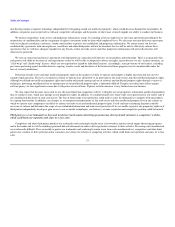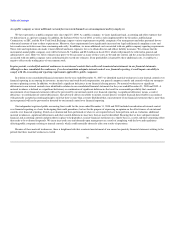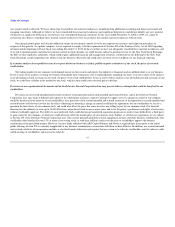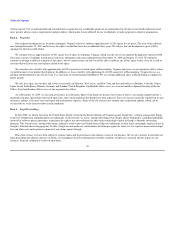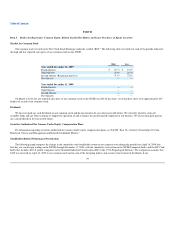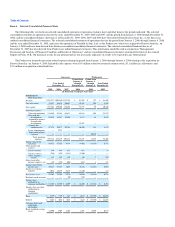Rosetta Stone 2009 Annual Report Download - page 35
Download and view the complete annual report
Please find page 35 of the 2009 Rosetta Stone annual report below. You can navigate through the pages in the report by either clicking on the pages listed below, or by using the keyword search tool below to find specific information within the annual report.
Table of Contents
also develop similar or superior technology independently by designing around our intellectual property, which would decrease demand for our products. In
addition, our patents may not provide us with any competitive advantages and the patents of others may seriously impede our ability to conduct our business.
We protect our products, trade secrets and proprietary information, in part, by requiring all of our employees to enter into agreements providing for the
maintenance of confidentiality and the assignment of rights to inventions made by them while employed by us. We also enter into non-disclosure agreements
with our technical consultants, customers, vendors and resellers to protect our confidential and proprietary information. We cannot assure you that our
confidentiality agreements with our employees, consultants and other third parties will not be breached, that we will be able to effectively enforce these
agreements, that we will have adequate remedies for any breach, or that our trade secrets and other proprietary information will not be disclosed or will
otherwise be protected.
We rely on contractual and license agreements with third parties in connection with their use of our products and technology. There is no guarantee that
such parties will abide by the terms of such agreements or that we will be able to adequately enforce our rights, in part because we rely, in many instances, on
"click-wrap" and "shrink-wrap" licenses, which are not negotiated or signed by individual licensees. Accordingly, some provisions of our licenses, including
provisions protecting against unauthorized use, copying, transfer, resale and disclosure of the licensed software program, may be unenforceable under the
laws of several jurisdictions.
Protection of trade secret and other intellectual property rights in the markets in which we operate and compete is highly uncertain and may involve
complex legal questions. The laws of countries in which we operate may afford little or no protection to our trade secrets and other intellectual property rights.
Although we defend our intellectual property rights and combat unlicensed copying and use of software and intellectual property rights through a variety of
techniques, preventing unauthorized use or infringement of our intellectual property rights is inherently difficult. Despite our enforcement efforts against
software piracy, we lose significant revenue due to illegal use of our software. If piracy activities increase, it may further harm our business.
We also expect that the more successful we are, the more likely that competitors will try to illegally use our proprietary information and develop products
that are similar to ours, which may infringe on our proprietary rights. In addition, we could potentially lose future trade secret protection for our source code if
any unauthorized disclosure of such code occurs. The loss of future trade secret protection could make it easier for third parties to compete with our products
by copying functionality. In addition, any changes in, or unexpected interpretations of, the trade secret and other intellectual property laws in any country in
which we operate may compromise our ability to enforce our trade secret and intellectual property rights. Costly and time-consuming litigation could be
necessary to enforce and determine the scope of our confidential information and trade secret protection. If we are unable to protect our proprietary rights or if
third parties independently develop or gain access to our or similar technologies, our business, revenue, reputation and competitive position could be harmed.
Third-party use of our trademarks as keywords in internet search engine advertising programs may direct potential customers to competitors' websites,
which could harm our reputation and cause us to lose sales.
Competitors and other third parties purchase our trademarks and confusingly similar terms as keywords in internet search engine advertising programs
and in the header and text of the resulting sponsored link advertisements in order to divert potential customers to their websites. Preventing such unauthorized
use is inherently difficult. If we are unable to protect our trademarks and confusingly similar terms from such unauthorized use, competitors and other third
parties may continue to drive potential online customers away from our websites to competing websites, which could harm our reputation and cause us to lose
sales.
33


